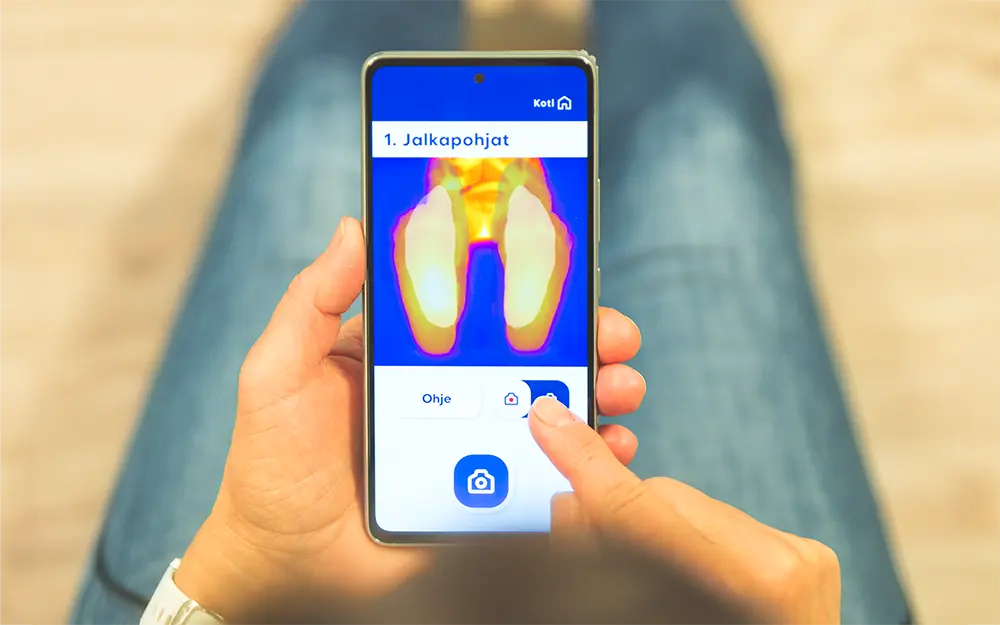Thermidas Kotikuvantaminen
Kotikuvantamisen ratkaisuamme testataan parhaillaan niin Suomessa kuin maailmallakin.
Tilaa uutiskirjeemme, niin pidämme sinut ajan tasalla uusimmasta kehityksestä.
Joka vuosi yli 35 miljoonaa diabeettista jalkahaavaa johtaa 4,5 miljoonaan amputaatioon, maksaen globaalille terveydenhuoltojärjestelmälle jopa 150 miljardia dollaria.

Yhteistyössä Thermidaksen kanssa pyrimme hyödyntämään teknologiaa, dataa ja tekoälyä parantaaksemme diabetekseen liittyvien jalkasairauksien, erityisesti haavaumien, hoitoa ja hoitotuloksia.
Prof. Brian Kennon, MD
National Lead of Diabetes in Scotland
Tutkittua tietoa
Useissa tutkimuksissa on nostettu esille jalkojen lämpötilan kotiseurannan merkitys. Kohonnut lämpötila on tunnettu riskitekijä, joka edeltää diabettista jalkahaavaa kohtalaisen tai korkean riskin potilailla. Thermidaksen kotikuvantamisratkaisu on ensimmäinen laatuaan maailmassa, ja se tarjoaa myös yksityishenkilöille mahdollisuuden seurata ennakoivasti jalkojen lämpötilaeroja.IWGDF Guidelines
“Given the high incidence of subsequent diabetic foot complications to the sound foot in patients with a history of proximal LEA and patients being treated for a wound, practice of daily temperature monitoring of a single foot has the potential to significantly improve outcomes and reduce resource utilization in this challenging high-risk population.”
“At-home daily foot temperature monitoring and reduction of ambulatory activity in response to hotspots reduce the risk of a DFU in moderate or high risk people with a low level of certainty.”
Golledge J, Fernando ME, Alahakoon C, Lazzarini PA, Aan de Stegge WB, van Netten JJ, Bus SA. Efficacy of at home monitoring of foot temperature for risk reduction of diabetes-related foot ulcer: A meta-analysis. Diabetes Metab Res Rev. 2022 Sep;38(6):e3549. doi: 10.1002/dmrr.3549. Epub 2022 Jun 8. PMID: 35605998; PMCID: PMC9541448.
“Remote foot temperature monitoring is a cost-effective addition to standard of care in patients with diabetic neuropathy at a moderate-to-high risk of DFU and subsequent amputation. Further, reduction in DFU and associated complications may result in improvements in the patient’s quality of life and mental health.“
“High temperature gradients between feet may predict the onset of neuropathic ulceration and self-monitoring may reduce the risk of ulceration.“
“These results suggest that at-home patient self-monitoring with daily foot temperatures may be an effective adjunctive tool to prevent foot complications in individuals at high risk for lower-extremity ulceration and amputation.”
Pilottitutkimus Yhdistyneissä Kunigaskunnissa
NHS:n jalkojenhoitoryhmä toteuttaa parhaillaan tutkimusta, jossa arvioidaan kotikäyttöön soveltuvan lämpökuvantamisjärjestelmän vaikutusta diabeettisten jalkahaavojen riskipotilaiden hoidossa.
